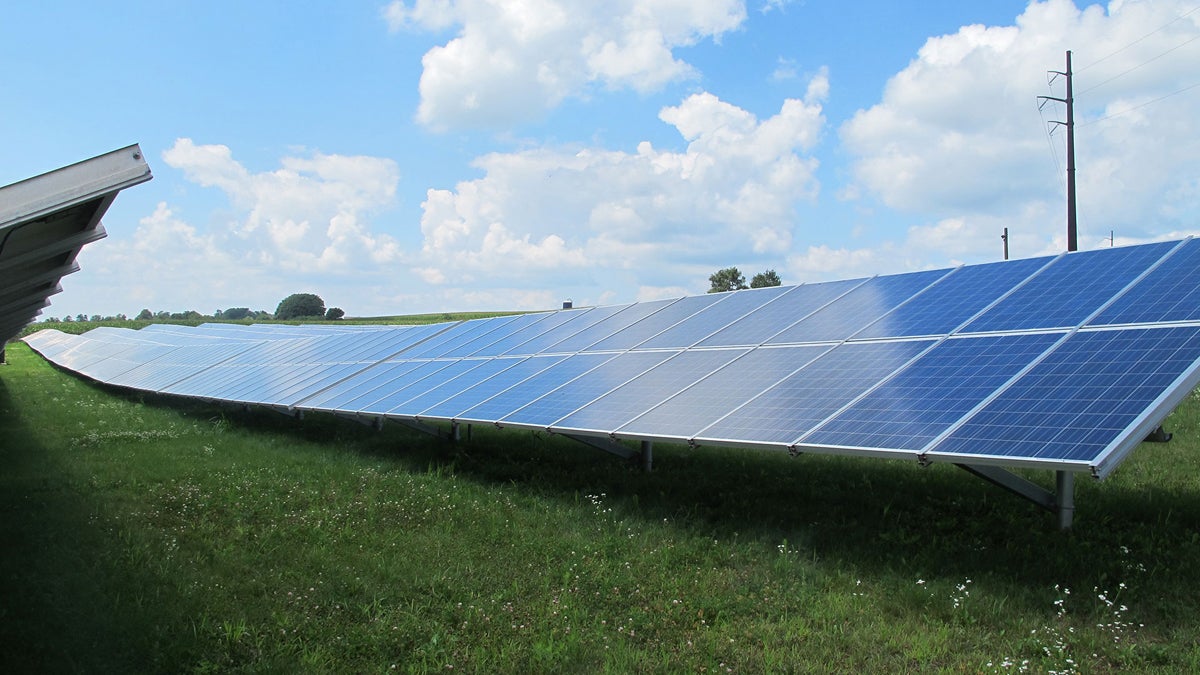The Obama solar success story that nobody talks about

(NewsWorks File Photo)
Remember Solyndra? The solar-panel manufacturing firm that defaulted on a guaranteed federal loan? The firm whose ’11 bankruptcy was spun by the Republicans as a metaphor for Obama socialist overreach?
Well, guess what. While nobody has been paying attention – least of all, the press – the same federal green-energy loan program, post-Solyndra, has been racking up a string of successes.
Funny how the Republicans have failed to point this out. But hey, they’re only interested in cherry-picking failures. And the so-called “liberal” press, which lavished sumptuous coverage on the Solyndra debacle, is only interested in news when it’s bad.
My curiousity about the Department of Energy’s loan program – did it still exist, or did Solyndra kill it? – was prompted by something that President Obama said Tuesday night, during his State of the Union address. Just a passing remark: “We believed we could reduce our dependence on foreign oil and protect our planet….Every three weeks, we bring online as much solar power as we did in all of 2008.”
So I surmised that if we’re indeed bringing more solar online, then surely that loan program must still exist, right?
Turns out, it does. Big time.
Turns out, Solyndra’s failure was basically a speed bump. Turns out, Obama’s energy department has thus far loaned $34 billion to a slew of clean-green startups, and defaulted on only $780 million – a loss rate of just 2.3 percent. And Solyndra’s default still accounts for most of that $780 million. All told, 20 clean-green projects, launched with Obama loans, are now operating and generating revenue. And the loan program, thanks to its ongoing collection of interest payments, is already $30 million in the black.
One would think that Republicans would applaud a win for taxpayers, a program that partners with private enterprise to create clean-energy jobs and reduce our dependence on foreign oil. But no, of course not. They paid attention only when “Solyndra” was useful as an attack word (by 2012, “Solyndra” was replaced by “Benghazi”).
But it doesn’t matter what they think. What matters is what the private-sector entrepreneurs think. You know, the business people who think about investments, not ideology.
Two months ago, a spokesman for NRG Energy Inc. (which owns three solar power plants) told Reuters, “The loan program has been successful in bringing to market good projects with good credit support that absolutely would not have been built” if not for those loans.
That same month, Nancy Pfund, a managing partner of a venture capital firm that has holdings in several energy companies backed by the Obama program, told the Associated Press: “It’s very hard to get commercial-scale financing, especially for these types of projects. (The loans) have been a very positive force in that respect.”
Post-Solyndra, a plant in Colorado produces photovoltaic energy (a form of solar power) – reputedly the largest of its kind in the world. A plant in Kansas produces cellulosic ethanol from non-edible waste. There are solar thermal plants and wind farms in California and Arizona. Some projects have reportedly inked deals to sell clean power to utility companies. One project in California has already paid back its $450 million nearly 10 years ahead of schedule.
As for Solyndra, yeah, that was a washout back in the day. But as scandals go, it was woefully overblown even then. The Solyndra loan was actually approved by the Bush administration, via an Energy Department program that preceded Obama’s. The busted loan – $535 million – equaled the taxpayer tab for two days of our military occupation in Iraq. (Two days. Not a misprint.) Government-aided business ventures fail all the time anyway, it’s the nature of business. And the Obama loan program isn’t exactly a new concept; the feds have long been a financial nurturer of cutting-edge private enterprise, in everything from synthetic rubber to the Internet.
Now we have the post-Solyndra success stories. And if you really want perspective, this delicious little factoid should be the clincher:
Since the new ethanol biorefinery opened in Hugoton, Kansas last October (I mentioned that project earlier), the small town’s economy has boomed. New stores and motels are being built, new jobs are being created. All because Obama’s loan program – created by the ’09 economic stimulus law – funnelled money to this red-state backwater. Care to guess who came to the opening and praised the program?
Governor and ex-congressman Sam Brownback and Senator Pat Roberts. Two conservative Republicans who railed against the stimulus law and voted against it in ’09. But gee, now they think the stimulus’ loan program is just great. The governor says he “strongly supports” it.
I bet he does.
Solyndra?! What’s that?
Follow me on Twitter, @dickpolman1, and on Facebook.
WHYY is your source for fact-based, in-depth journalism and information. As a nonprofit organization, we rely on financial support from readers like you. Please give today.

